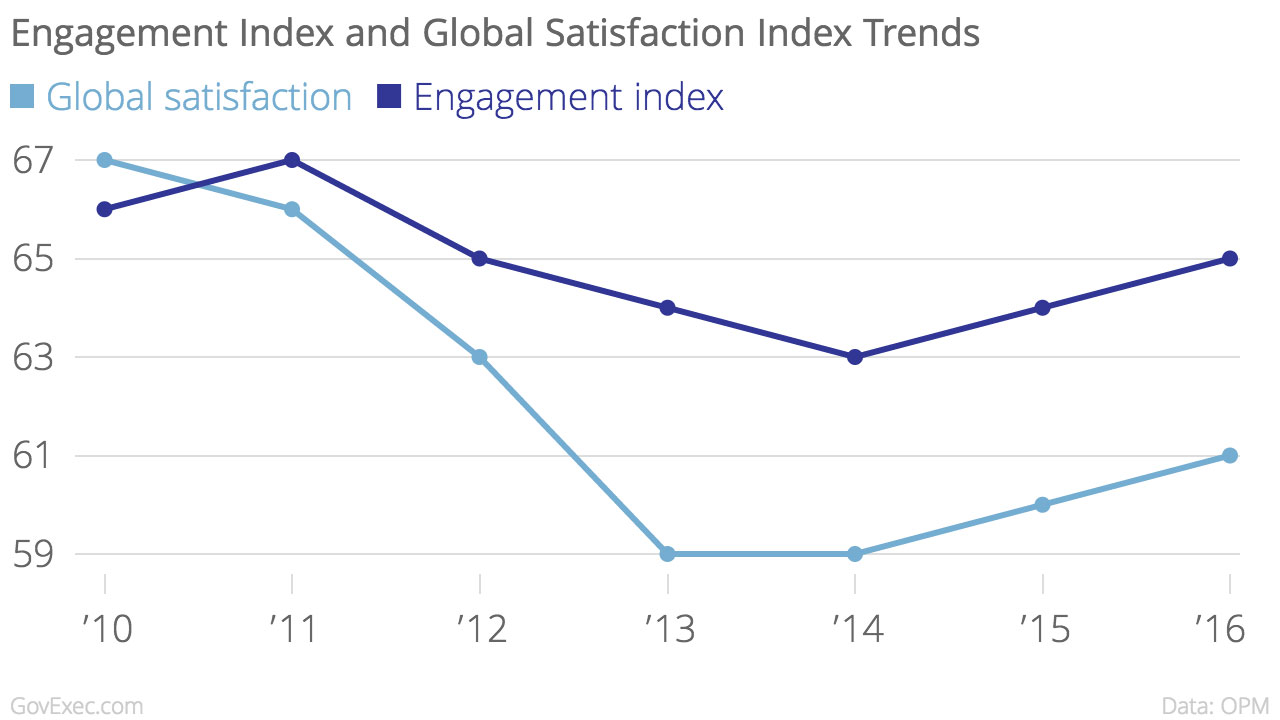Federal Employees Slightly Happier, More Engaged At Work in 2016
More than two-thirds of component bureaus saw increases in engagement.
Federal employees are marginally more engaged in and satisfied with their jobs this year than last, according to a new governmentwide survey measuring the workforce’s attitudes on morale, management and compensation. This marks the second consecutive year the numbers ticked up.
The Office of Personnel Management, which administers the Federal Employee Viewpoint Survey, said its “global satisfaction index” increased 1 point, from 60 in 2015 to 61 this year. The index measures employees’ happiness with pay, their individual jobs and the overall organization. Sixty-five percent of feds said they were engaged with their jobs, up from 64 percent in 2015.
The governmentwide results in both of those measures had slid for four consecutive years prior to the 2015 survey.
More than two-thirds of the 587 major bureaus across the federal government saw employee engagement increase from 2015. About one in five saw the scores jump by at least 6 percent. More than 50 individual items on the survey saw an uptick in 2016, according to OPM, and no question saw scores decline from 2015.
In a call with reporters Monday, OPM acting Director Beth Cobert said agencies implementing best practices like soliciting greater input from employees, holding town halls, more explicit recognition of “a job well done” and training had all contributed to the improved results. She added “well-deserved” pay raises in recent years and more budget certainty have also helped to boost morale.

The Homeland Security Department, one of the lowest ranked places to work in all of government and the large agency in which satisfaction had dropped the most significantly since 2010, saw a 3 percentage point increase in its engagement score, from 53 percent last year to 56 percent this year. DHS Secretary Jeh Johnson -- who has emphasized employee morale throughout his tenure -- acknowledged “we’re still at the bottom of the list,” but said the 2016 results marked a turning point.
“I believe and I hope this is the beginning of a trend where we’re going to see increase after increase after increase,” Johnson said. The secretary pointed to more employee engagements with top leadership, the return of the secretary awards program, improved communication and increased transparency in the hiring and promotion process as the impetus for the increased scores. DHS’ Immigration and Customs Enforcement and Customs and Border Protection bureaus experienced particular improvements in 2016.
NASA Administrator Charlie Bolden, whose agency has for years ranked at the top of FEVS results, said he owed his success to mid-level managers.
“That’s who deserves the credit,” Bolden said. “That’s where the rubber meets the road.”
Cobert singled out Johnson and Bolden as leaders particularly committed to making improvements to employee engagement and satisfaction, and said their work was emblematic of that being done across the administration.
The survey included results from employees from April through June of 2016. More than 407,000 employees from 80 agencies participated, with a response rate of 45.8 percent.








